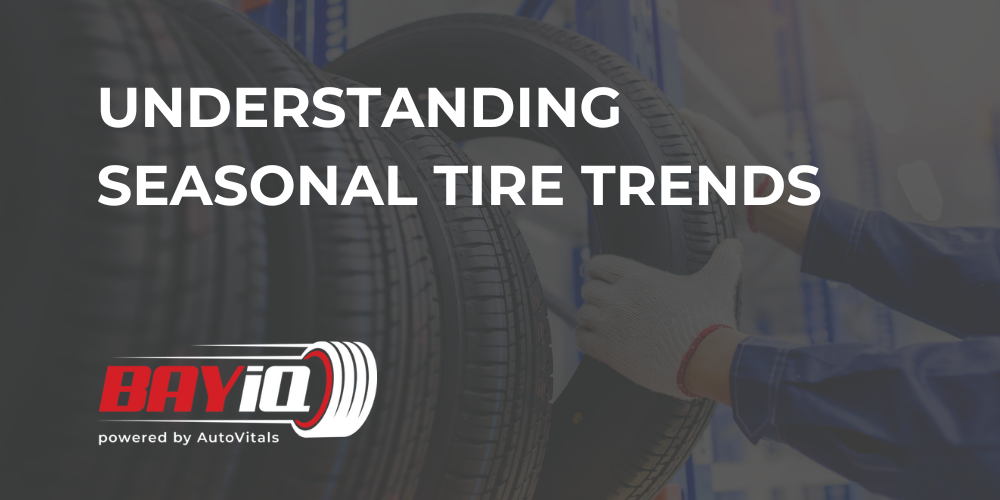The tire industry is driven by changing weather patterns, consumer behavior, and advancements in vehicle technology. For tire shops, staying attuned to these shifts isn’t just a matter of convenience, it’s imperative to the success of your business. Understanding and preparing for seasonal tire trends can help you refine your approach, increase customer loyalty, and drive long-term growth for your shop.
- What Are Seasonal Tire Trends?
- Key Seasonal Trends in the Tire Industry
- How Seasonal Tire Trends Impact Tire Shop Strategy
- Leveraging Technology to Stay Ahead
- Practical Tips for Tire Shops
- Conclusion
What Are Seasonal Tire Trends?
Seasonal tire trends refer to the varying demand for specific tire types based on seasonal weather conditions and driving habits. These trends often dictate what customers need and expect, impacting inventory management, marketing strategies, and customer service efforts.
Examples of Seasonal Tire Trends:
- Summer Performance Tires: Popular for improved handling and safety during warm months.
- Winter Tires: Essential for snowy or icy conditions, offering better traction and durability.
- All-Season Tires: A perennial favorite for their versatility and year-round reliability.
Factors Influencing Tire Trends:
- Regional Weather Patterns: Snow-prone areas see a spike in winter tire demand, while milder regions may favor all-weather options.
- Consumer Behavior: Seasonal habits such as holiday travel, summer road trips, or back-to-school preparations affect purchasing decisions.
- Vehicle Technology: With the rise of electric vehicles (EVs), there’s an increasing demand for specialized tires tailored to EV performance and efficiency.
Key Seasonal Trends in the Tire Industry
Spring and Summer
- High-Performance Tires: Warmer weather encourages drivers to seek performance-focused tires for better handling, speed, and safety. These are especially popular among road trip enthusiasts.
- Seasonal Preparation: Many drivers schedule tire inspections and replacements to recover from winter wear and ensure safe spring and summer driving.
- Increased Road Travel: As vacation plans kick into gear, the demand for durable, long-lasting tires rises.
Fall and Winter
- Winter Tires: Snowy and icy conditions drive the need for winter-specific tires. These tires provide enhanced traction, durability, and safety in harsh climates.
- All-Weather Options: For regions with mild winters, all-weather tires remain a popular choice, blending versatility with reliability.
- Safety-Focused Features: Drivers prioritize tires designed to perform in wet or icy conditions, focusing on safety and durability.
Year-Round Considerations
- All-Season Tires: These remain a consistent favorite for their balance of performance and adaptability across seasons.
- Routine Maintenance: Seasonal transitions often lead to increased demand for tire rotations, alignments, and maintenance services, ensuring optimal tire performance throughout the year.
How Seasonal Tire Trends Impact Tire Shop Strategy
Marketing Strategy
- Timing Promotions: Aligning promotions with seasonal needs, such as winter tire specials or summer road trip packages, can maximize sales.
- Targeted Advertising: Using email and text marketing tools to target customers based on regional weather patterns ensures relevance and effectiveness.
- Bundled Services: Offering packages like tire inspections, installations, and maintenance encourages repeat business and builds customer trust.
- Optimizing Scheduling and Bay Availability: Leave additional time slots open for walk-ins and prioritize seasonal tire installations over routine maintenance tasks during these high-demand periods, like the rush before the first snow.
Customer Engagement
- Education and Awareness: Informing customers about the importance of seasonal tires enhances their driving safety and builds your shop’s credibility.
- Loyalty Programs: Incentivizing repeat visits with loyalty rewards for seasonal tire changes and maintenance fosters long-term relationships.
- Personalized Recommendations: Tailoring your marketing strategy and tire suggestions based on driving habits, vehicle type, and regional conditions enhances customer satisfaction.
Leveraging Technology to Stay Ahead
Predictive Analytics
Historical sales data and market trends can help forecast seasonal demand. This allows tire shops to:
- Optimize Inventory: Stock the right tires at the right time to prevent shortages or overstocking.
- Plan Staffing: Ensure adequate personnel are available during peak seasons.
Automated Marketing Tools
Platforms like BayIQ offer powerful tools to:
- Send Service Reminders: Timely notifications for tire rotations and replacements keep customers engaged.
- Run Promotions: Target specific customer segments with offers tailored to their seasonal needs.
Customer Relationship Management (CRM)
A robust CRM system can:
- Track Preferences: Monitor customer history to tailor future services and promotions.
- Streamline Communication: Provide seamless and personalized customer interactions, enhancing the overall experience.
Practical Tips for Tire Shops
- Plan Ahead
- Start preparing for seasonal demand at least one season in advance.
- Monitor local weather patterns for sudden shifts that might affect customer needs.
- Partner Strategically
- Collaborate with tire manufacturers for timely shipments, bulk discounts, and exclusive products.
- Use platforms like BayIQ to simplify marketing efforts.
- Train Your Team
- Ensure staff understand the nuances of seasonal tire recommendations, from performance benefits to safety features.
- Equip technicians with the skills to efficiently handle seasonal tire installations, inspections, and replacements.
Conclusion
By aligning your tire shop strategy with these trends, you can anticipate customer needs, optimize inventory, and deliver superior service year-round. Leveraging tools like BayIQ makes it easier to stay ahead, from predictive analytics and automated marketing to robust CRM systems. Start planning your seasonal strategy today to stay ahead of the curve - and the competition!

